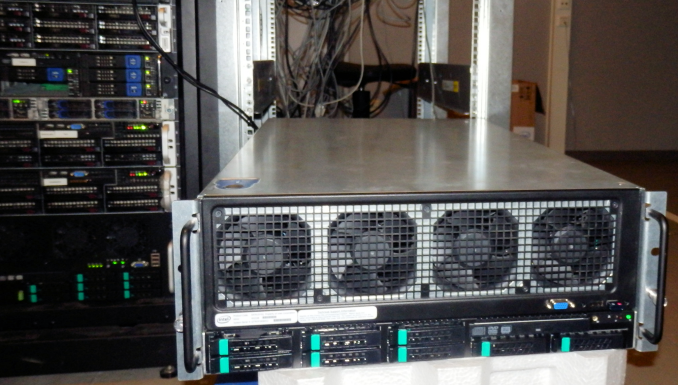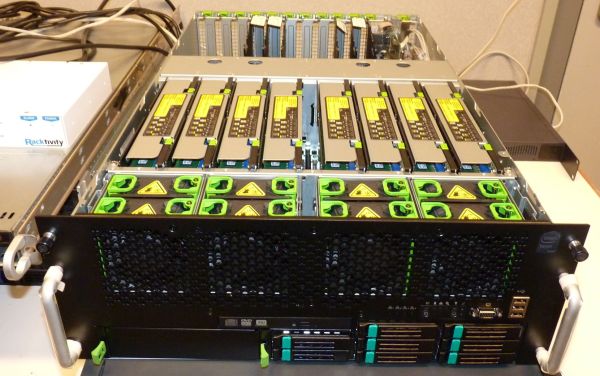The Intel Xeon E7-8800 v3 Review: The POWER8 Killer?
by Johan De Gelas on May 8, 2015 8:00 AM EST- Posted in
- CPUs
- IT Computing
- Intel
- Xeon
- Haswell
- Enterprise
- server
- Enterprise CPUs
- POWER
- POWER8
Benchmark Configuration
As far as reliability is concerned, while we little reason to doubt that the quad Xeon OEM systems out there are the pinnacle of reliability, our initial experience with Xeon E7 v3 has not been as rosy. Our updated and upgraded Quad Xeon Brickland system was only finally stable after many firmware updates, with its issues sorted out just a few hours before the launch of the Xeon E7 v3. Unfortunately this means our time testing the stable Xeon E7 v3 was a bit more limited than we would have liked.
Meanwhile to make the comparison more interesting, we decided to include both the Quad Xeon "Westmere-EX" as well as the "Nehalem-EX". Remember these heavy duty, high RAS servers continue to be used for much longer in the data center than their dual socket counterparts, 5 years or more are no exception. Of course, the comparison would not be complete without the latest dual Xeon 2699 v3 server.
All testing has been done on 64 bit Ubuntu Linux 14.04 (kernel 3.13.0-51, gcc version 4.8.2).
Intel S4TR1SY3Q "Brickland" IVT-EX 4U-server
The latest and greatest from Intel consists of the following components:
| CPU | 4x Xeon E7-8890v3 2.5 GHz 18c, 45 MB L3, 165W TDP or 4x Xeon E7-4890 v2 (D1 stepping) 2.8GHz 15 cores, 37.5MB L3, 155W TDP |
| RAM | 256 GB, 32x 8 GB Micron DDR-4-2100 at 1600MHz or 256 GB, 32x8GB Samsung 8GB DDR3 M393B1K70DH0-YK0 at 1333MHz |
| Motherboard | Intel CRB Baseboard "Thunder Ridge" |
| Chipset | Intel C602J |
| PSU | 2x1200W (2+0) |
Total amount of DIMM slots is 96. When using 64GB LRDIMMs, this server can offer up to 6TB of RAM.
If only two cores are active, the 8890 can boost the clockspeed to 3.3 GHz (AVX code: 3.2 GHz). The 4890v2 reaches 3.4 GHz in that situation. Even with all cores active, 2.9 GHz is possible (AVX code: 2.6 GHz).
Intel Quanta QSCC-4R Benchmark Configuration
The previous quad Xeon E7 server, as reviewed here.
| CPU | 4x Xeon X7560 at 2.26GHz, or 4x Xeon E7-4870 at 2.4GHz |
| RAM | 16x8GB Samsung 8GB DDR3 M393B1K70DH0-YK0 at 1066MHz |
| Motherboard | QCI QSSC-S4R 31S4RMB00B0 |
| Chipset | Intel 7500 |
| BIOS version | QSSC-S4R.QCI.01.00.S012,031420111618 |
| PSU | 4x850W Delta DPS-850FB A S3F E62433-004 850W |
The server can accept up to 64 32GB Load Reduced DIMMs (LR-DIMMs) or 2TB.
Intel's Xeon E5 Server – "Wildcat Pass" (2U Chassis)
Finally, we have our Xeon E5 v3 server:
| CPU | Two Intel Xeon processor E5-2699 v3 (2.3GHz, 18c, 45MB L3, 145W) |
| RAM | 128GB (8x16GB) Samsung M393A2G40DB0 (RDIMM) |
| Internal Disks | 2x Intel MLC SSD710 200GB |
| Motherboard | Intel Server Board Wilcat pass |
| Chipset | Intel Wellsburg B0 |
| BIOS version | August the 9th, 2014 |
| PSU | Delta Electronics 750W DPS-750XB A (80+ Platinum) |
Every server was outfitted with two 200 GB S3700 SSDs.












146 Comments
View All Comments
Dmcq - Saturday, May 9, 2015 - link
Well they'll sell where performance is an absolute must but they won't pose a problem to Intel as they won't take a large part of the market and they'd keep prices high. I see the main danger to Intel being in 64 bit ARMs eating the server market from below. I suppose one could have cheap and low power POWER machines to attack the main market but somehow it just seems unlikely with their background.Guest8 - Saturday, May 9, 2015 - link
Uh did you see Anandtech's reviews on the latest ARM server? The thing barely keeps up with an Avoton. Intel is well aware of ARM based servers and has preemptively disARMed the threat. If ARM could ever deliver Xeon class performance it would look like Power8.melgross - Saturday, May 9, 2015 - link
Chip TDP is mostly a concern for the chip itself. Other areas contribute far more waste heat than the CPU does.PowerTrumps - Saturday, May 9, 2015 - link
Power doesn't need to have a TDP of 1000W but 200W is nothing given the performance and efficiency advantage of the processors and Power hypervisor. When you can consolidate 2, 4 and 10 2 socket Intel servers into 1 x 2 socket Power8 server that is 10 x 2 x 135W = 2700 overall Watts vs 400W with the Power server. Power reduces the overall energy, cooling and rack space consumption.KAlmquist - Saturday, May 9, 2015 - link
$4115 E5-2699 (18C, 2.3 Ghz (3.6 Ghz turbo), max memory 768 GB)$5896 E7-8880 (18C, 2.3 Ghz (3.1 Ghz turbo), max memory 1536 GB)
That's a big premium for the E7--enough that it probably doesn't make sense to buy an 8 socket system just to run a bunch of applications in parallel. The E7 makes sense only if you need more than 36 cores to have access to the same memory.
PowerTrumps - Saturday, May 9, 2015 - link
I really enjoyed the article as well as the many data and comparison charts. It is unfortunate that most of your statements, assessments and comparisons about Power and with Intel to Power were either wrong, misleading, not fully explained or out of context. I invite the author to contact me and I will be happy to walk you through all of this so you can update this article as well as consider a future article that shows the true advantage Power8 and OpenPower truly has in the data center and the greater value available to customers.KAlmquist - Saturday, May 9, 2015 - link
I would be surprised if anybody working for Anandtech is going to contact an anonymous commentator. You can point out portions of the article that you think are wrong or misleading in this comment section.To do a really good article on Power8, Anandtech needs a vendor to give Anandtech access to a system to review.
PowerTrumps - Sunday, May 10, 2015 - link
Admittedly I assumed when I registered for the PowerTrumps account some time ago I used a email address which they could look up. But, your point is taken. Brett Murphy with Software Information Systems (aka SIS) www.thinksis.com. Email at bmurphy@thinksis.com. If I pointed out all of the mistakes my comment would look like a blog which many don't appreciate. I have my own blog for that. I like well written articles and happy to accept criticism or shortcomings with IBM Power - just use accurate data and not misrepresent anything. Before Anandtech reviews a Power8 server, my assessment is they need to understand what makes Power tick and how it is different than Intel or SPARC for that matter. Hope they contact me.thunng8 - Sunday, May 10, 2015 - link
I too would like a more detailed review of the Power8.Some of the text in the article made me laugh on how wrong they are.
For example, the great surprise that Intel is not on top.. Well anandtech has never test any Power systems before..
And it is laughable to make any conclusions based on running of 7zip. Just about any serious enterprise server benchmark shows a greater than 2x performance advantage per core in favor of Power compared to the best Xeons. So that 50% advantage is way less than expected.
Btw Power7 for most of its life bested Xeon in performance by very large margins. It is just now that IBM have opened up Power to other vendor that makes it exciting.
JohanAnandtech - Monday, May 11, 2015 - link
I welcome constructive critism. And yes, we only had access to an IBM Power8 dev machine, so we only got a small part of the machine (1 core/2GB)."Some of the text in the article made me laugh on how wrong they are."
That is pretty low. Without any pointer or argument, nobody can check your claims. Please state your concerns or mail me.